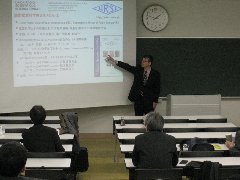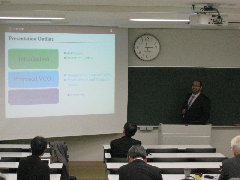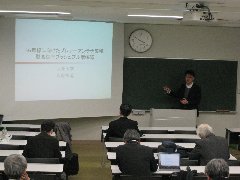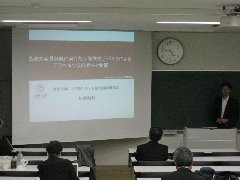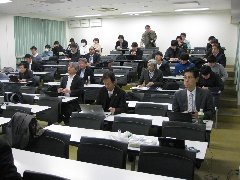1. Convener: Prof. Taiichi Otsuji (Tohoku University)
2. Date/time: 13:30 - 17:25, December 6th, 2019
3. Venue: Room No. 23, EE-Buld. 1F, Fucalty of Eng., Koorimoto Campus, Kagoshima University, Kagoshima city, Kagoshima pref.
4. Registration fee: Free
5. Listed attendees: 20 persons
6. Technical arrangement: Prof. Taiichi Otsuji (Tohoku University)
7. Local arrangement: Prof. Kenjiro Nishikawa (Kagoshima University)
8. Session title: "Semiconductor device technologies supporting high-speed big-capacity radio communications beyond 5G"
9. Sponsors:
- IEEE MTT-S Japan Chapter
- IEEE AP-S Fukuoka Chapter
- IEEE VT-S Tokyo/Japan Chapter
- IEEE SSCS Japan Chapter
- IEEE EDS Japan Chapter
10. Presentations:
11.Reception:
It held from 18:30 to 20:30 at Juan, Kurobagoshima-Chuou Ten, Kagoshima city, Kagoshiam pref. The number of attendees was 20 persons.
12.The Steering committee meeting:
It took place from 13:00 to 13:25 on December 6th, 2018, at Room No. 23, EE-Buld. 1F, Faculty of Eng., Koorimoto Campus, Kagoshima University.
13. Concluding Remarks
As mobile radio communication technology is increasing in speed and capacity, 5G releases are approaching next year, and research and development of next-generation, beyond 5G and 6G are also emarging. This workshop focused on semiconductor device technology that supports high-speed, high-capacity wireless communications of and beyond 5G, attracting 20 attendees. Four leading researchers working at the forefront of a series of fields ranging from devices to circuits and systems presented the state-of-the-art technology and ideas. They stimulated deep discussions among attendees, helping deepening a common understanding of future prospects.
Dr. Fumiyuki Adachi (Tohoku Univ.) explained the technology roadmap up to and beyond the 5th generation (5G) mobile communication system. Efforts have been made to improve spectrum utilization efficiency up to 4G, but improving energy utilization efficiency (Whr/bit) is also an important issue after 5G. Distributed MIMO radio is expected as a breakthrough. The impact and R&D issues beyond 5G-6G toward further advancement were addressed.
Dr. Baccarat Adele (Kyushu Univ.) gave a presentation on the latest achievements regarding 5G CMOS oscillators, specifically Ku-to-K band CMOS-VCO (Voltage Controlled Oscillator) phase noise reduction technology. By introducing LC series resonance on the low or high frequency side of the oscillation band, he proposed that the Q value of the oscillation band and the suppression ratio can be improved simultaneously. And in the 25 GHz band, low power consumption equivalent to the conventional one and low transport noise exceeding the conventional performance in a wide specific band have been realized.
Dr. Takeshi Kuboki (Kyushu Univ.) gave a presentation on the latest achievements regarding a planar antenna integrated high-efficiency push-pull amplifier for 5G radio. First, 5 GHz band high-efficiency planar slot antenna integrated CMOS push-pull power amplifier. Secondly, as a 300 GHz band integrated planar antenna technology for post 5G systems, impedance matching other than 50 ohms for amplifiers on board was proposed. By improving power load efficiency, a maximum PAE of 30.9% was achieved. The superiority of independent slot antenna was discussed.
Dr. Kazutoshi Kato (Kyushu Univ.) gave a presentation on the latest achievements regarding terahertz wave control by semiconductor optical devices for high-speed and high-capacity wireless communication. Photomixing diodes capable of generating coherent millimeter and submillimeter waves by mixing two laser lights can easily achieve phase modulation in the output of the terahertz waves by controlling the phase between the two light waves, but the remaining critical issue is the phase noise of laser light. It has been shown that the problem can be solved by arraying a novel photonic phase modulator capable of chromatic dispersion control and a photonic integration with an antenna.
In summary, this meeting was very valuable opportunity to understand and share the status of R&D and technical issues and prospects towards beyond 5G and 6G.
To view larger photo, please click above photo then type password.



